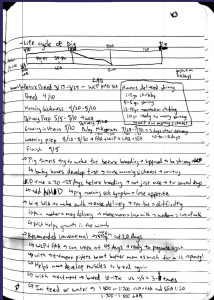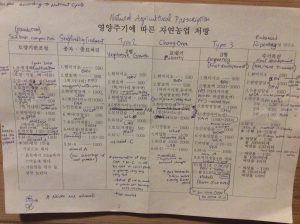When feeding animals the recommended amount of OHN in the water is diluted at 1:700. It’s important not to deviate too far away from this ratio until you have been practicing for a while and can really notice the subtle effects of the solutions. An expert will dilute by feeling.
The way an animal obtains the solutions by weight is typically a bigger animal will drink more than a smaller animal.
- drake answered 7 years ago
There is no need to continually sprinkle sugar on the top unless you are getting odor. If you are getting odor, the first thing to do is to try to submerge the fish under the liquid, sometimes with a large stone. If the odor still persists, then add more sugar to balance it out.
And by odor, I mean, there will be a smell, but the smell should not be rotting. Fish sauce and KNF Fuel should smell sweet like the stuff you buy at the store for food. If it smells like dead animal or rotting eggs, that is what I am referring to as odor.
To go more specifically to the situation you have, I don’t see anything necessarily wrong with it. I have found it is nearly impossible to add too much sugar to the KNF Fuel. But, I would stop adding more at this point especially as you are 1:2 with sugar.
Often I will have fish that is not submerged and it will grow a little white or yellow molds on it. That’s fine. There is still no smell and it feels like a mummy. So well preserved.
The main microbe action in the KNF Fuel eventually comes from KNF Police, aka Lactic Acid Bacteria, and they are hardcore and will operate just fine even in a super/over saturated environment. They are beasts.
- drake answered 7 years ago
There is a a lot to do with pigs and chickens in KNF.
Master Cho outlines in his Advanced Chicken Training how to raise the birds with an expanding cage along with a very strict diet to promote intestines 3x the length of standard american practice. There is also a way to formulate the feeds so that you can recycle what otherwise would be waste and still get eggs so hard they dent wooden tables.
Raising pigs the KNF way also has incredible benefit. I am now able to feed the mothers so that they are able to lactate longer and when I wean at 40 days I have incredibly thick sausage like dense piglets!
Here is a page from my swine notes on the feeding cycle
- drake answered 7 years ago
KNF Foliar Chart suggests 4 tsp/gal WsCaPhos during fruit puberty and 4 tsp/gal WCA during Fruit Maturity.
- Jonathan Traxler answered 7 years ago
The information for the Solution Calculator App comes verbatim from Master Cho, you can watch his lectures on the nutritive cycle, and here is his handout in the original Korean.
I don’t really have a good reason for you why he leaves seawater out. Sometimes folks in the audience will ask and he will be like “oh yeah, add that too”. KNF is really about intuition and less about this shotgun approach, but this app is designed to get you to be able to hit the target at least close enough for government work.
You will also notice that on his sheet there are the proprietary minerals which he refuses to teach to even his most advanced students, so most likely this knowledge will die with him and we will forever be left hampered by an old man’s greed. whoops.
- drake answered 7 years ago
When using KNF Food it makes sense to use a few, just like when you go to a potluck, you don’t just load up on the potatoes, you grab some meat, some chips, some dip, a bit of salad, a few brownies and maybe some tasty pudding. Plants are no different. They want the mixed plate too. All this helps to lead to a more balanced diet if done right.
But, say you are watching your weight, so maybe you forgo the brownies and double up on the salad. This is the same concept for plants and how KNF Food can alter their growth behavior, so getting to know your solutions will help you create the perfect mix to help your plant get what it needs. Knowing what food does what to your plant is a matter of really understanding the Cho theory of the house model, which unfortunately was the first seminar I took with him and I neglected to record it on video so I only have the vaguest of notes. Still this shouldn’t be hard to reverse engineer with contemporary science and knowing what nutrients each plant aggregates and then what those chemicals do in terms of modern plant science.
I note that you want to mix all the KNF Foods together, and I recommend for the most part to store them separately, but yes combine them all into one jar, but just enough for a month’s worth of working material. This makes it convenient so you don’t always have to be mixing, but also helps them store better individually as noted elsewhere.
Also please note that making them and storing separately is crucial, and I think that is implied in your question. Take this analogy to demonstrate the concept: If I want curry and a cake but instead I throw all the ingredients in the oven then cook it, I will end up with neither curry nor cake, but if i cook them separately and then put them on my plate once they are cooked, there is a good chance I will be able to enjoy both the curry and cake within the limits of this analogy.
When we start to think of KNF in this way, things become almost intuitive, and this is what I hope to share with you. The concepts we already know the answer to, and with slightly different thinking we become masters of KNF.
- drake answered 7 years ago
When making KNF Fuel, if you start with bad fish, it’s like they say, bad fish.
If you study a good batch of KNF Fuel you will find that it is predominantly KNF Police that are preserving the solution. This is not to say that there are not other microbes doing their work to break down and disassemble the amino acids, but if other microbes get in there first and the KNF Police are unable to get dominance because of that, it’s best to start over.
The solutions you have tried to rectify it are exactly what I would recommend to try to fix the situation. The one last suggestion is to make sure all the fish is submerged below the liquid layer or covered entirely with sugar so there is no air exposure. In this anaerobic environment at room temperatures the KNF Police will have the environmental conditions in their favor and maybe be able to quell the riot.
Your nose knows though. If the smell is like rotting flesh, the KNF Police are not in charge and your body is warning you of high pathogens present and metabolizing the system. Masking this scent with other things like wood chips is just that, a mask. The face behind it needs to be transformed.
Under no circumstances put this in your body, unless somehow the scent turns to sweet, and I mean sweet, fish sauce. I’d wait at least 6 months with this batch, and if you can’t rectify the rotting smell in the next week, perhaps just put it away and smell it then. No sense throwing it out unless you live in a tiny home.
If you do go to throw it out, put it into a large compost pile and let the thermophilic microbes do their decomposing magic. Kill it with fire as they say.
- drake answered 7 years ago
Every time you water these rates and formulations can be used.
Most folks do it once or twice a week, and it depends on your cost to benefit ratio. For a large parcel like an orchard, it may be largely infeasible to apply these that frequently.
However, if you are doing a small operation on a high value crop, or you have automation to put these into fertigation, then the ease and simplicity makes it possible to apply every time.
The only way to ‘overdose’ your plants is to increase the potency of the formulations, or to simply drown your plants by over application.
- drake answered 7 years ago
This isn’t from a KNF source but Viktor Shauberger’s work with water heavily revolves around the “anomaly point” of water which is +4 degrees celcius or 39.2 degrees farenheit. This is the point where water is it’s densest, most capable of carrying nutrients, and highest in what Schauberger described as carbonic acid and “carbones” or “mother substances”. According to his theory, when a body of water has its temperature approaching this anomally point it increases how much mineral and “carbone” substances it will hold, maintains its carrying capacity as long as its temperature is stable and decreases as the water’s temperature is moving away from the anomaly point. These are each called positive, neutral, and negative temperature gradients respectively. On the other hand the opposite happens for what is called “aggravated” oxygen as the water is exposed to heat, which acclerates decomposition and promotes potential pathogens. The problem you may run into with freezing FPJ is as it freezes it may precipitate previously dissolved nutrients, enzymes, yeasts, etc. This might leave you with a really diluted frozen water and a super concentrated syrup of sugar that may not dissolve properly without warming the solution which would then most likely totally poop on your FPJ shelf life after that. But then again we can’t know for sure until we try.
- Brian Sutley answered 7 years ago
I make cheese and has excess whey. This is very acidic. I add a pouch of rock dust to it and stir from time to time. With the increased surface area of rock dust as well as the acidic environment of whey, it leaches minerals to the water. I then strain and use the water in my aquaponics, wicking beds and garden.
One idea is to get rods of different metals from the internet and using a colloidal silver machine, electrolysing them to leach the ions into the water. It would be hard to get the diverse metals though.
Still, I think using rock dust is a better option as it provides a diverse range of minerals and ones there are enough worms in your soil to process it.
Another option is to mine the minerals using tap-rooted plants like dandelion, comfrey, fennel, milk parsley, sea holy, coltsfoot and preparing a weed tea using these plants.
Diversity is the key.
- Gürkan Yeniçeri answered 7 years ago

